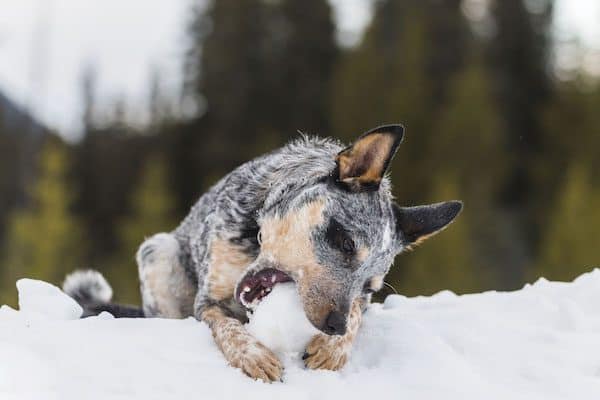You’re walking down the street and spy a handsome mid-size dog with a rounded head, pointy ears, and a stocky physique. While these characteristics grab your attention, you’re really intrigued by his unusual marled blue coat. Stopping to inquire about the breed of this attractive dog, you find out he’s an (aptly named) Blue Heeler. If you stayed and chatted for a while, you’d also learn that, though the dog’s owner may be gregarious, the Blue Heeler couldn’t care less that you’re there.

Look at that gorgeous coat! Blue Heeler by Shutterstock.
Blue Heelers are fiercely independent dogs, who are usually devoted to one person. This characteristic stems from the types of canines Australian George Elliott used to develop the breed in 1840, a mix of native dingos with Collies and other herding dogs. It also comes from their original purpose, which was to herd cattle independent of any instruction from their owners. So, these tough, sturdy, and intelligent dogs with a high work drive (also called Australian Heelers, Queensland Heelers, and Australian Cattle Dogs) are often more comfortable herding the family cat than being adored by a stranger.
But, never fear: Blue Heelers are devoted family dogs who bring joy to everyone in their daily lives. Just be sure to teach the kiddies that this particular breed is not comfortable being hugged or dressed up like a hula girl. Blue Heelers tend to take life seriously and are always on the alert in case they need to perform a task. They are protectors and very good guard dogs, and their sense of self (if dogs have a sense of self) is grounded in their ability to do whatever their owner asks. This makes them very trainable — and training is needed as they will herd everything in sight if not taught differently.

Start training your Blue Heeler at an early age. A 10-week-old Blue Heeler by Shutterstock.
If you’re envisioning yourself frolicking in a field with your new Blue Heeler, make it a long frolic. These are very active dogs who need exercise daily. They also need some sort of task to do, whether it’s agility training, guarding the house, or fetching your slippers. If you’re an apartment dweller, don’t give up on having this breed entirely — just know that you’ll need to get this dog outside for long runs and play in an enclosed area like a dog park. Do keep an eye on your pup once there, though, as she can dominate other dogs and get into tiffs.
Be prepared for a long life of love if you do decide a Blue Heeler is for you. This breed lives 15 years on average and is very healthy, with only a few common health issues, including eye problems, hip dysplasia, and deafness. The 35-to-45-pound dog stands 17-to-20-inches tall, a size that attracts both city dwellers and those with a house and yard. His blue-speckled or red-speckled coat with tan markings is very unusual, and the rather noble carriage of his “personage” attracts attention.

A blue heeler dog by Shutterstock.
So when you’re walking down the street and just have to meet that marled-blue dog sitting on the coffee shop patio, be forewarned — you may very likely end up with one of your own.
But if a Blue Heeler doesn’t sound like a good fit for your family, you can still enjoy the breed with the fun YouTube videos below of the dogs in action.
A Blue Heeler herds sheep:
The cuteness — Blue Heeler puppies:
A Blue Heeler picks up her toys:
Read more breed profiles on Dogster:
- Breed Fads Are Bad for Dogs. Just Look at the Tibetan Mastiff
- Get to Know the Tibetan Spaniel: Little Lion of Tibet
- Get to Know the Norwegian Lundehund: The Rarest AKC Breed of Them All
The post Get to Know the Blue Heeler: The Fiercely Independent Charmer appeared first on Dogster.
No comments:
Post a Comment